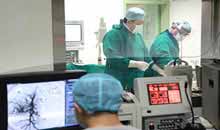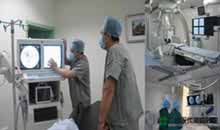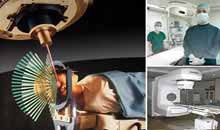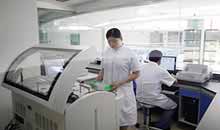- Basic
- Symptoms
- Diagnosis
- Treatments
What is Leukemia?
Leukemia is a clonal malignant disease caused by the abnormality of blood-forming stem cells. A large number of abnormal white blood cells, which have lost their ability of further differentiation and maturation and stay in different stages of cell development, are produced in bone marrow and other blood-forming tissues. These abnormal cells abundantly proliferate, accumulate and infiltrate other organs and tissues, meanwhile, inhibit the normal blood-forming functions. That is why leukemia patients always have symptoms like anemia, hemorrhage, infection and infiltration of other organs.
Incidence of Leukemia
The incidence of leukemia accounts for a percentage of 2.5 among all the cancers. All over the world, about 47,150 people are diagnosed with leukemia every year, and 23,540 people die of leukemia yearly. Leukemia is the Top 1 pediatric cancer in incidence. Children between 0-4 years old are in the highest risk, and the incidences ratio between boys and girls is 7:5.
Common Types of Leukemia
According to the source and morphological characteristics of the cells, leukemia can be divided into below types:
1、Acute myeloid leukemia: it is caused by the abnormal proliferation of myeloid white blood cells. It has the characteristic that abnormal cells in bone marrow rapidly proliferate affecting the production of normal blood cells.
2、Chronic myeloid leukemia: it is a clonal proliferative disease of blood-forming stem cells. Its major characteristics include bone marrow hyperplasia, peripheral blood leukocytes increase and enlargement of spleen.
3、Acute lymphoblastic leukemia: it is a kind of rapidly progressing leukemia caused when the lymphoblast uncontrollably proliferate and abnormally differentiate or its differentiation is obstructed, which result in formation of abundant immature white blood cells.
4、Chronic lymphocytic leukemia: it is a malignant cancer that affects lymph cells leading to immature differentiation of them. These immature lymph cells gather within bone marrow, inhibit its normal blood-forming function and spread in the body through blood.
Causes of Leukemia
Although many factors are considered to have relation with the incidence of leukemia, the causes of leukemia still are not completely known. So far, it is still believed that the causes of leukemia are mainly related with infection, radioactive factors, chemical factors and hereditary factors.
Nursing Methods of Leukemia
Dietary nursing methods
1. Eat more foods containing rich protein and calories.
2. Take in more foods that contain rich vitamins
3. Have more foods that contain rich iron elements
Life care
1. Take medicines and go to hospital for recheck regularly
2. Establish healthy life habit
3. Prevent infection by keeping a clean environment at home.
4. Pay attention to food safety and health and have the tableware and foods sterilized
What supports you can get from Modern Cancer Hospital Guangzhou?
Study proved that a muti-disciplinary medical group, which is composed of surgical oncology, medical oncology, department of traditional Chinese medicine, pathology department, department of radiology, anesthetist and professional nurses, can make a more effective, more suitable and more economical treatment plan so as to improve the effect of cancer treatment.
Modern Cancer Hospital Guangzhou, with its multi-disciplinary “one-stop” medical system, offers comprehensive diagnosis and treatment service to patients. It not only offers patients with all-round considerate medical service, but also improves the medical efficiency and level without increasing patient’s burden. Communication channels between patients and doctors are various, which include online consultation, email, on-phone communication and face-to-face communication. All these communication channels allow patients to enjoy the service of consultation and help them fight against cancers. Medical groups that services patients include doctors, nurses, dietitians and interpreters, by whom all levels of needs of patients from different countries can be met. Under this smooth communication environment, patients can peacefully cooperate with the treatment.
Patients with early leukemia may not feel any discomfort and they often cannot identify the symptoms of its different types, thus many of them miss the optimum time for treatment. So what are the symptoms for each type of leukemia?
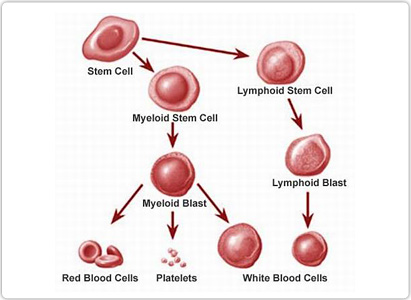
Symptoms of Chronic Leukemia
1. In the early stages of chronic leukemia, symptoms may not appear for a long time, thus the patients cannot feel any discomfort. Doctors will usually find abnormal blood picture or splenomegaly (enlarged spleen) during a routine checkup or examinations for other diseases and then the patients are diagnosed with chronic leukemia.
2. When symptoms do appear, they are generally mild at first and progress gradually. Common symptoms of chronic leukemia may include: fatigue, low heat, excessive sweat or night sweats, weight loss for unknown reason, and hyperthyroidism, in addition, left upper abdominal distension and sensation of fullness after eating (due to enlarged spleen).
3. Patients with chronic leukemia often manifest as pale complexion, pale lips, and splenomegaly which is the most obvious symptom and which often has reached umbilical plane when patients visit a doctor, furthermore, tenderness in the lower part of sternum. Patients with advanced chronic leukemia will appear tiny red spots under the skin, mucous, and painless mass in the tissues of eye sockets and skull.
Symptoms of Acute Leukemia
1. Anemia: hematopoietic abnormalities of bone marrow leads to low number of both red blood cells and hemoglobin, thus anemia will be developed and half of the patients can develop severe anemia.
2. Fever: leukemia itself can cause fever, furthermore, due to decreased immunity, once pathogens invading body, thus it tends to cause infection and results in fever.
3. Bleeding: due to stasis and infiltration of the large number of leukemia cells in blood vessels, low number of platelets, coagulation abnormalities and infection, patients will appear scattered red spots, purpura or petechia from head to foot, nosebleed, gingival bleeding or excessive menstruation, furthermore, blurred vision resulting from fundus hemorrhage, coma and even death due to intracranial hemorrhage can be caused.
4. Gastrointestinal failure: it can result from agents used in chemotherapy and radiation therapy which will affect gastrointestinal function.
5. Hyperuricemia: it can be caused by chemotherapy, radiotherapy and application of cortical hormone, what’s more, with high concentration of uric acid supersaturated soon and precipitated, oliguria and anuria will be caused by extensive damage of kidney and the formation of uric acid stones.
Symptoms of Leukemia in Children
Symptoms of early leukemia in Children are pale complexion, fatigue, lassitude, loss of appetite, nasal bleeding or bleeding gums, etc.; few patients firstly manifest as fever and bone joint pain which is similar to rheumatic fever.
1. Anemia: it appears early and aggravates progressively, besides, it manifests as pale complexion, weakness, shortness of breath after activity, and tachycardia (too fast heartbeat).
2. Fever: it often occurs with uncertain types and mostly is irregular fever with no shivering. Leukemia fevers mostly manifest as low heat and antibiotic treatment is ineffective; secondary infections (respiratory tract infections, urinary tract infection, etc.) mostly are high heat.
3. Bleeding: main reasons of bleeding are firstly, leukemia cell infiltration thus bone marrow megakaryocyte will be inhibited, causing low number of platelet; secondly, impaired liver function causes insufficient production of fibrinogen, thrombinogen and accelerin; thirdly, capillary permeability increases. Most of bleeding occurs in the skin and mucous membrane, manifesting as purpura, petechia, nosebleed, gingival bleeding, gastrointestinal hemorrhage and hematuria, in addition, occasionally intracranial hemorrhage which is one of the important causes of death.
To know and identify the symptoms of leukemia can help patients detect it early and then get treatment in time.
What are detections for leukemia? Most people are inclined to know the detections of leukemia, for that can help to find out related symptoms and perform treatments in time.

Common Detections Of Leukemia
1. Blood routine examination. It is to take a little blood from finger or ear lobe to check the quantity of red blood cells, white blood cells and platelet, meanwhile to classify the white blood cells. Normally, juvenile blood cells (for short is juvenile cells) should not appear in peripheral blood. But when someone is suffering from leukemia, juvenile cells can be seen in blood routine test for they are released to peripheral blood while they are not differentiated and mature enough in bone marrow.
2. Routine examination for bone marrow. If it is suspected to have leukemia, bone marrow puncture test is necessary to count and classify all kinds of cells from bone marrow. Normally juvenile cells take not over 5% in bone marrow. But when one develops leukemia, his juvenile cells can increase at most 30% more, especially for acute leukemia of children, that can reach 80-100% more in bone marrow.
Bone marrow examination is a most weightily proof to diagnose leukemia. It is not difficult to detect leukemia by combing with clinical signs and physical examinations when this bone marrow examination indicating an obvious increase of juvenile cells in bone marrow. However, treatments would be different as the types of leukemia vary. Then further examinations should be taken to confirm the type of leukemia.
1. Immune typing examination. It generally has to take around 2 ml bone marrow to identify and classify the leukemia cells with a reagent named clonal antibody.
2. Cytogenetic examination. This examination also has to take about 2 ml bone marrow to know if any abnormality of leukemia essence and chromosomes. The prognosis usually would be poorer to the leukemia patients with chromosome disorder than those without chromosome abnormality.
3. Examination of cerebrospinal fluid is to confirm if leukemia cells encroach on brain and spinal system by drawing out a little cerebrospinal fluid from lumbar spinal canal of patient for chemical examination. If being encroached, that is what medically called leukemia of central nervous system.
Specialist from Modern Cancer Hospital Guangzhou figured out that, except what mentioned above, there are X-ray examination (including chest X-ray, skull X-ray and bone X-rays of limbs and so on) examination of ocular fundus, ECG(electrocardiogram), ultrasonic examination of liver and spleen, blood biochemistry, immune functions, related virus examination and so on. All those examinations can indicate that whether the main organs of patient are working normally and if any encroachment of leukemia cells occurs, which at the same time are the preparation and direction for further treatments.
Leukemia is a malignant disease of blood-forming system. It can happen in all ages. Acute leukemia is seriously threatening people's health as it suddenly happens, develops fast and is dangerous. With the advancing of medical science, many acute leukemia patients are able to have their painfulness well relieved through active treatment. In fact, nowadays, to relieve the painfulness of leukemia is no more the terminal target of treatment. In stead, to improve the patients' life quality and prolong their lives have become the emphasis of researches. So far, treatment methods for leukemia include:
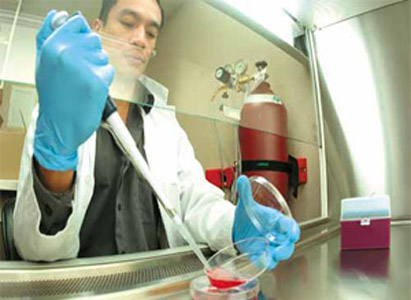
Bone Marrow Transplantation
Bone marrow transplantation is performed after cleaning out the cancer cells and abnormal clonal cells in the patient's body and shut down the pathogenesis through intensive radiation therapy, chemotherapy or other immune inhibiting methods. It is to implant the normal blood-forming stem cells from the patient or others to the leukemia patient to help reconstruct their normal blood-forming and immunity functions, thus to achieve the treatment purpose. It is the most effective treatment method for leukemia, through which about 50% of leukemia patients can have long survival time.
Chemotherapy
Chemotherapy also is an important treatment method for advanced leukemia. It aims to clean out the clonal cells of leukemia and reconstruct bone marrow to regain normal blood-forming function. Chemotherapy can be divided into: induction chemotherapy, chemotherapy after relief, chemotherapy after treatment, intensive treatment. It can effectively relieve symptoms of leukemia, extend patient's life. Moreover, it is a necessary step before bone marrow transplantation.
Combination of Traditional Chinese Medicine and Western Medicine
While chemotherapy and biotherapy bring many toxic side effects to human body, a combination with Chinese medicine in treating advanced leukemia can effectively reduce those toxic side effects. For advanced leukemia patients who have wide metastasis and are in poor condition, thus cannot tolerant the side effects of chemotherapy, they can undergo expectant treatment with Chinese medicine, which has obvious effect in improving life quality and extending life.
Biotherapy
Research on biotherapy has gained great progress in recent years. DC-CIK biotherapy techniques aim to activate the immune mechanism to improve the immunity of the patient and eliminate the cancer cells as well as inhibit their reproducing, thus to prevent recurrence and metastasis.
Experts from Modern Cancer Hospital Guangzhou remind that, as there are many kinds of leukemia, treatment plan must be made after comprehensive evaluation of patient's personal condition. Although there is still a long way for the medical circle to completely cure leukemia, leukemia patients can still have their disease controlled by following doctor's suggestion and choosing suitable treatment, in addition, paying attention to the daily diets.
If you have any questions, please contact us via online consultation, email or phone call. If you find our website useful, please follow our FaceBook and YouTube, health information will be updated regularly.









